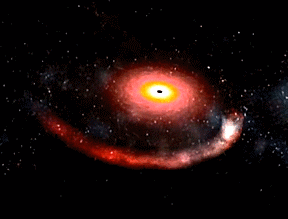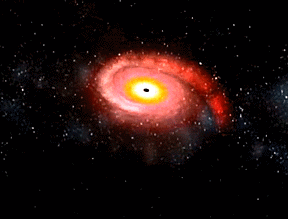I Was Wondering If You Could Go In Depth, At Least To A Degree About How Incredibly Dense Objects Have
I was wondering if you could go in depth, at least to a degree about how incredibly dense objects have strong enough gravity to distort light. To me that's one of the wildest concepts I can imagine, not that I expect you to be all knowing but maybe you've got a good article or something? I don't recall if you've ever made posts about the theory of relativity. Sorry for the long ask!
Well, I know only the basics, things I study in my free time, however, I can try to explain. The distortion of space-time is described by Einstein’s Theory of General Reality. The more massive an object, the more its curvature will be in the space-time fabric.


This distortion in light is known as a gravitational lensing. The gravitational lensing is formed due to a space-time distortion caused by the presence of a large mass body between a distant light source and an observer.


These distortions are widely observed through globular clusters.
Since the amount of lensing depends on the total mass of the cluster, gravitational lensing can be used to ‘weigh’ clusters. This has considerably improved our understanding of the distribution of the ‘hidden’ dark matter in galaxy clusters and hence in the Universe as a whole. The effect of gravitational lensing also allowed a first step towards revealing the mystery of the dark energy.


As gravitational lenses function as magnification glasses it is possible to use them to study distant galaxies from the early Universe, which otherwise would be impossible to see.

Gravitational lensing happens on all scales – the gravitational field of galaxies and clusters of galaxies can lens light, but so can smaller objects such as stars and planets. Even the mass of our own bodies will lens light passing near us a tiny bit, although the effect is too small to ever measure.
More Posts from Ocrim1967 and Others

Google Classroom FINALLY lets you add a “Materials” section under “Classwork”
Literally two days ago they added the ability to add a new kind of post under a Classwork topic. “Materials” (instead of Assignment or Question)
This is your workaround for losing the “About” page. Set up a topic called “About” or “Resources”, then add a “Materials” post under that topic. Boom, done!

ALSO, if you created a Google Classroom before the update, and only have the Stream and People pages, you can now manually add a Classwork page by clicking the grey question mark in the bottom left corner, then selecting “Add Classwork page”.

Try it out, today!
Your Friendly Neighborhood Google for Education Certified Trainer,
-WCT









(Source)
NASA’s New Planet Hunter Reveals a Sky Full of Stars

NASA’s newest planet-hunting satellite — the Transiting Exoplanet Survey Satellite, or TESS for short — has just released its first science image using all of its cameras to capture a huge swath of the sky! TESS is NASA’s next step in the search for planets outside our solar system, called exoplanets.

This spectacular image, the first released using all four of TESS’ cameras, shows the satellite’s full field of view. It captures parts of a dozen constellations, from Capricornus (the Sea Goat) to Pictor (the Painter’s Easel) — though it might be hard to find familiar constellations among all these stars! The image even includes the Large and Small Magellanic Clouds, our galaxy’s two largest companion galaxies.
The science community calls this image “first light,” but don’t let that fool you — TESS has been seeing light since it launched in April. A first light image like this is released to show off the first science-quality image taken after a mission starts collecting science data, highlighting a spacecraft’s capabilities.

TESS has been busy since it launched from NASA’s Kennedy Space Center in Cape Canaveral, Florida. First TESS needed to get into position, which required a push from the Moon. After nearly a month in space, the satellite passed about 5,000 miles from the Moon, whose gravity gave it the boost it needed to get into a special orbit that will keep it stable and maximize its view of the sky.

During those first few weeks, we also got a sneak peek of the sky through one of TESS’s four cameras. This test image captured over 200,000 stars in just two seconds! The spacecraft was pointed toward the constellation Centaurus when it snapped this picture. The bright star Beta Centauri is visible at the lower left edge, and the edge of the Coalsack Nebula is in the right upper corner.

After settling into orbit, scientists ran a number of checks on TESS, including testing its ability to collect a set of stable images over a prolonged period of time. TESS not only proved its ability to perform this task, it also got a surprise! A comet named C/2018 N1 passed through TESS’s cameras for about 17 hours in July.
The images show a treasure trove of cosmic curiosities. There are some stars whose brightness changes over time and asteroids visible as small moving white dots. You can even see an arc of stray light from Mars, which is located outside the image, moving across the screen.

Now that TESS has settled into orbit and has been thoroughly tested, it’s digging into its main mission of finding planets around other stars. How will it spot something as tiny and faint as a planet trillions of miles away? The trick is to look at the star!
So far, most of the exoplanets we’ve found were detected by looking for tiny dips in the brightness of their host stars. These dips are caused by the planet passing between us and its star – an event called a transit. Over its first two years, TESS will stare at 200,000 of the nearest and brightest stars in the sky to look for transits to identify stars with planets.

TESS will be building on the legacy of NASA’s Kepler spacecraft, which also used transits to find exoplanets. TESS’s target stars are about 10 times closer than Kepler’s, so they’ll tend to be brighter. Because they’re closer and brighter, TESS’s target stars will be ideal candidates for follow-up studies with current and future observatories.

TESS is challenging over 200,000 of our stellar neighbors to a staring contest! Who knows what new amazing planets we’ll find?
The TESS mission is led by MIT and came together with the help of many different partners. You can keep up with the latest from the TESS mission by following mission updates.
Make sure to follow us on Tumblr for your regular dose of space: http://nasa.tumblr.com.




















This Is How To Bring Dark Skies Back In An Increasingly Developed World
“A dark night sky is something we not only all deserve, it’s something that we could very easily have for a relatively small investment. The benefits, in addition to long-term cost savings, education, and the environmental positives, can be taken in all at once by everyone who both lives in, or simply passes through, your town.
And for those of you still asking, “what benefit is that?” As soon as you encounter your first dark sky community, you’ll see for yourself that there’s no explanation required. To take it all in, just look up.”
When was the last time you saw the Milky Way? If you’re like 99% of the United States or Europe, it wasn’t from your own backyard. While you might assume that’s because we need to have well-lit areas where most of us live, that’s only partially correct. It’s because we choose to have brightly-lit areas to meet our safety and commercial nighttime needs, but there’s a fundamental difference between well-lit and brightly-lit. More than 20 independent communities have taken all the steps necessary to restore darkness to their areas, following the recommendations and getting certified by the IDA: the International Dark Sky Association.
Forget about asking, “why aren’t there more?” Instead, try being the change you want to see, and work to bring dark skies, as well as health and environmental benefits, back to your own community!


Chandra Spots Extremely Long Cosmic Jet in Early Universe
http://www.sci-news.com/astronomy/chandra-extremely-long-cosmic-jet-early-universe-09436.html
Our Favorite Valentines Throughout the Universe
Today is Valentine’s Day. What better way to express that you love someone than with an intergalactic love gram? Check out some of our favorites and send them to all of your cosmic companions:
Your love is galactic

The Hubble Space Telescope revolutionized nearly all areas of astronomical research — and captured some truly lovely images. Here, a pair of intersecting galaxies swirl into the shape of a rose as a result of gravitational tidal pull. What type of roses are you getting for your love — red or galactic?
I think you’re n{ice}

IceBridge is the largest airborne survey of Earth’s polar ice ever flown. It captures 3-D views of Arctic and Antarctic ice sheets, ice shelves and sea ice. This lovely heart-shaped glacier feature was discovered in northwest Greenland during an IceBridge flight in 2017. Which of your lover’s features would you say are the coolest?
You’re absolutely magnetic

Even though we can’t see them, magnetic fields are all around us. One of the solar system’s largest magnetospheres belongs to Jupiter. Right now, our Juno spacecraft is providing scientists with their first glimpses of this unseen force. Is your attraction to your loved one magnetic?
You’re MARS-velous

This heart-shaped feature on the Martian landscape was captured by our Mars Reconnaissance Orbiter. It was created by a small impact crater that blew darker material on the surface away. What impact has your loved one had on you?
I <3 you

From three billion miles away, Pluto sent a “love note” back to Earth, via our New Horizons spacecraft. This stunning image of Pluto’s “heart” shows one of the world’s most dominant features, estimated to be 1,000 miles (1,600 km) across at its widest point. Will you pass this love note on to someone special in your life?
Light of my life

Our Solar Dynamics Observatory keeps an eye on our closest star that brings energy to you and your love. The observatory helps us understand where the Sun’s energy comes from, how the inside of the Sun works, how energy is stored and released in the Sun’s atmosphere and much more. Who would you say is your ray of sunshine?
Do any of these cosmic phenomena remind you of someone in your universe? Download these cards here to send to all the stars in your sky.
Want something from the Red Planet to match your bouquet of red roses? Here is our collection of Martian Valentines.
Make sure to follow us on Tumblr for your regular dose of space: http://nasa.tumblr.com
What is Gravitational Lensing?
A gravitational lens is a distribution of matter (such as a cluster of galaxies) between a distant light source and an observer, that is capable of bending the light from the source as the light travels towards the observer. This effect is known as gravitational lensing, and the amount of bending is one of the predictions of Albert Einstein’s general theory of relativity.

This illustration shows how gravitational lensing works. The gravity of a large galaxy cluster is so strong, it bends, brightens and distorts the light of distant galaxies behind it. The scale has been greatly exaggerated; in reality, the distant galaxy is much further away and much smaller. Credit: NASA, ESA, L. Calcada
There are three classes of gravitational lensing:
1° Strong lensing: where there are easily visible distortions such as the formation of Einstein rings, arcs, and multiple images.

Einstein ring. credit: NASA/ESA&Hubble
2° Weak lensing: where the distortions of background sources are much smaller and can only be detected by analyzing large numbers of sources in a statistical way to find coherent distortions of only a few percent. The lensing shows up statistically as a preferred stretching of the background objects perpendicular to the direction to the centre of the lens. By measuring the shapes and orientations of large numbers of distant galaxies, their orientations can be averaged to measure the shear of the lensing field in any region. This, in turn, can be used to reconstruct the mass distribution in the area: in particular, the background distribution of dark matter can be reconstructed. Since galaxies are intrinsically elliptical and the weak gravitational lensing signal is small, a very large number of galaxies must be used in these surveys.

The effects of foreground galaxy cluster mass on background galaxy shapes. The upper left panel shows (projected onto the plane of the sky) the shapes of cluster members (in yellow) and background galaxies (in white), ignoring the effects of weak lensing. The lower right panel shows this same scenario, but includes the effects of lensing. The middle panel shows a 3-d representation of the positions of cluster and source galaxies, relative to the observer. Note that the background galaxies appear stretched tangentially around the cluster.
3° Microlensing: where no distortion in shape can be seen but the amount of light received from a background object changes in time. The lensing object may be stars in the Milky Way in one typical case, with the background source being stars in a remote galaxy, or, in another case, an even more distant quasar. The effect is small, such that (in the case of strong lensing) even a galaxy with a mass more than 100 billion times that of the Sun will produce multiple images separated by only a few arcseconds. Galaxy clusters can produce separations of several arcminutes. In both cases the galaxies and sources are quite distant, many hundreds of megaparsecs away from our Galaxy.
Gravitational lenses act equally on all kinds of electromagnetic radiation, not just visible light. Weak lensing effects are being studied for the cosmic microwave background as well as galaxy surveys. Strong lenses have been observed in radio and x-ray regimes as well. If a strong lens produces multiple images, there will be a relative time delay between two paths: that is, in one image the lensed object will be observed before the other image.

As an exoplanet passes in front of a more distant star, its gravity causes the trajectory of the starlight to bend, and in some cases results in a brief brightening of the background star as seen by a telescope. The artistic concept illustrates this effect. This phenomenon of gravitational microlensing enables scientists to search for exoplanets that are too distant and dark to detect any other way.Credits: NASA Ames/JPL-Caltech/T. Pyle
Explanation in terms of space–time curvature

Simulated gravitational lensing by black hole by: Earther
In general relativity, light follows the curvature of spacetime, hence when light passes around a massive object, it is bent. This means that the light from an object on the other side will be bent towards an observer’s eye, just like an ordinary lens. In General Relativity the speed of light depends on the gravitational potential (aka the metric) and this bending can be viewed as a consequence of the light traveling along a gradient in light speed. Light rays are the boundary between the future, the spacelike, and the past regions. The gravitational attraction can be viewed as the motion of undisturbed objects in a background curved geometry or alternatively as the response of objects to a force in a flat geometry.

A galaxy perfectly aligned with a supernova (supernova PS1-10afx) acts as a cosmic magnifying glass, making it appear 100 billion times more dazzling than our Sun. Image credit: Anupreeta More/Kavli IPMU.
To learn more, click here.



Unusual Signal Suggests Neutron Star Destroyed by Black Hole
What created this unusual explosion? Three weeks ago, gravitational wave detectors in the USA and Europe – the LIGO and Virgo detectors – detected a burst of gravitational radiation that had the oscillating pattern expected when a black hole destroys a neutron star. One object in event S190814sv was best fit with a mass greater than five times the mass of the Sun – making it a good candidate for a black hole, while the other object appeared to have a mass less than three times the mass of the Sun – making it a good candidate for a neutron star. No similar event had been detected with gravitational waves before. Unfortunately, no light was seen from this explosion, light that might have been triggered by the disrupting neutron star. It is theoretically possible that the lower mass object was also a black hole, even though no clear example of a black hole with such a low mass is known. The featured video was created to illustrate a previously suspected black hole - neutron star collision detected in light in 2005, specifically gamma-rays from the burst GRB 050724. The animated video starts with a foreground neutron star orbiting a black hole surrounded by an accretion disk. The black hole’s gravity then shreds the neutron star, creating a jet as debris falls into the black hole. S190814sv will continue to be researched, with clues about the nature of the objects involved possibly coming from future detections of similar systems. Illustration Video Credit: NASA, Dana Berry (Skyworks Digital)
-
 nicerumors reblogged this · 4 months ago
nicerumors reblogged this · 4 months ago -
 rusticottage liked this · 6 months ago
rusticottage liked this · 6 months ago -
 xploseof reblogged this · 7 months ago
xploseof reblogged this · 7 months ago -
 aeyriabird reblogged this · 8 months ago
aeyriabird reblogged this · 8 months ago -
 hellchilde reblogged this · 9 months ago
hellchilde reblogged this · 9 months ago -
 hellchilde reblogged this · 9 months ago
hellchilde reblogged this · 9 months ago -
 radplaidtacofan reblogged this · 9 months ago
radplaidtacofan reblogged this · 9 months ago -
 sleepy-soft-boi reblogged this · 9 months ago
sleepy-soft-boi reblogged this · 9 months ago -
 manebioniclegali reblogged this · 9 months ago
manebioniclegali reblogged this · 9 months ago -
 lxvi6 liked this · 9 months ago
lxvi6 liked this · 9 months ago -
 ezoptron liked this · 9 months ago
ezoptron liked this · 9 months ago -
 iacb-wa liked this · 9 months ago
iacb-wa liked this · 9 months ago -
 philam3 liked this · 9 months ago
philam3 liked this · 9 months ago -
 morebearsinheavenandearth reblogged this · 9 months ago
morebearsinheavenandearth reblogged this · 9 months ago -
 breathetoseethetruth liked this · 9 months ago
breathetoseethetruth liked this · 9 months ago -
 xploseof liked this · 9 months ago
xploseof liked this · 9 months ago -
 chocolateforyou liked this · 9 months ago
chocolateforyou liked this · 9 months ago -
 fushinusucariasblog liked this · 9 months ago
fushinusucariasblog liked this · 9 months ago -
 lukvle liked this · 9 months ago
lukvle liked this · 9 months ago -
 ash-clouds-obscuring reblogged this · 9 months ago
ash-clouds-obscuring reblogged this · 9 months ago -
 yanagi-uxinta reblogged this · 9 months ago
yanagi-uxinta reblogged this · 9 months ago -
 yanagi-uxinta liked this · 9 months ago
yanagi-uxinta liked this · 9 months ago -
 paleospace reblogged this · 9 months ago
paleospace reblogged this · 9 months ago -
 madssscientist liked this · 9 months ago
madssscientist liked this · 9 months ago -
 anxiousdepessedartist liked this · 9 months ago
anxiousdepessedartist liked this · 9 months ago -
 soloquiero-jugar reblogged this · 9 months ago
soloquiero-jugar reblogged this · 9 months ago -
 happyherringmakerrascal liked this · 9 months ago
happyherringmakerrascal liked this · 9 months ago -
 yakofalltrades reblogged this · 9 months ago
yakofalltrades reblogged this · 9 months ago -
 cold-like-my-city liked this · 9 months ago
cold-like-my-city liked this · 9 months ago -
 blxckchrry liked this · 9 months ago
blxckchrry liked this · 9 months ago -
 dragontales4 liked this · 9 months ago
dragontales4 liked this · 9 months ago -
 spaceexplorer99 liked this · 9 months ago
spaceexplorer99 liked this · 9 months ago -
 spacecasepc reblogged this · 9 months ago
spacecasepc reblogged this · 9 months ago -
 aeyriabird liked this · 9 months ago
aeyriabird liked this · 9 months ago -
 knarsisus reblogged this · 9 months ago
knarsisus reblogged this · 9 months ago -
 knarsisus liked this · 9 months ago
knarsisus liked this · 9 months ago -
 the-dishes-need-doing reblogged this · 9 months ago
the-dishes-need-doing reblogged this · 9 months ago -
 lovelyhomebody907 liked this · 9 months ago
lovelyhomebody907 liked this · 9 months ago -
 liviz223 reblogged this · 9 months ago
liviz223 reblogged this · 9 months ago -
 liviz223 liked this · 9 months ago
liviz223 liked this · 9 months ago -
 blastosaveschristmas liked this · 9 months ago
blastosaveschristmas liked this · 9 months ago -
 valgee reblogged this · 9 months ago
valgee reblogged this · 9 months ago -
 valgee liked this · 9 months ago
valgee liked this · 9 months ago -
 astral-athame liked this · 9 months ago
astral-athame liked this · 9 months ago -
 kirkfanatic liked this · 9 months ago
kirkfanatic liked this · 9 months ago -
 galacticshark reblogged this · 9 months ago
galacticshark reblogged this · 9 months ago -
 galacticshark liked this · 9 months ago
galacticshark liked this · 9 months ago